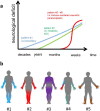Diagnosis of peripheral neuropathy
- PMID: 33324924
- PMCID: PMC7650053
- DOI: 10.1186/s42466-020-00064-2
Diagnosis of peripheral neuropathy
Abstract
Introduction: Peripheral neuropathy represents a spectrum of diseases with different etiologies. The most common causes are diabetes, exposure to toxic substances including alcohol and chemotherapeutics, immune-mediated conditions, and gene mutations. A thorough workup including clinical history and examination, nerve conduction studies, and comprehensive laboratory tests is warranted to identify treatable causes.
First steps: The variability of symptoms allows distinguishing characteristic clinical phenotypes of peripheral neuropathy that should be recognized in order to stratify the diagnostic workup accordingly. Nerve conduction studies are essential to determine the phenotype (axonal versus demyelinating) and severity. Laboratory tests, including genetic testing, CSF examination, nerve imaging, and nerve biopsy, represent additional clinical tests that can be useful in specific clinical scenarios.
Comments: We propose a flow chart based on five common basic clinical patterns of peripheral neuropathy. Based on these five clinical phenotypes, we suggest differential diagnostic pathways in order to establish the underlying cause.
Conclusions: The recognition of characteristic clinical phenotypes combined with nerve conduction studies allows pursuing subsequent diagnostic pathways that incorporate nerve conduction studies and additional diagnostic tests. This two-tiered approach promises higher yield and better cost-effectiveness in the diagnostic workup in patients with peripheral neuropathy.
Keywords: CIDP; Diabetic; Diagnosis; EMG; Hereditary amyloid transthyretin (ATTRv) amyloidosis; Nerve conduction studies; Peripheral neuropathy; Ultrasound.
© The Author(s) 2020.
Conflict of interest statement
Competing interestsNone.
Figures


References
LinkOut - more resources
Full Text Sources
Medical
Research Materials
